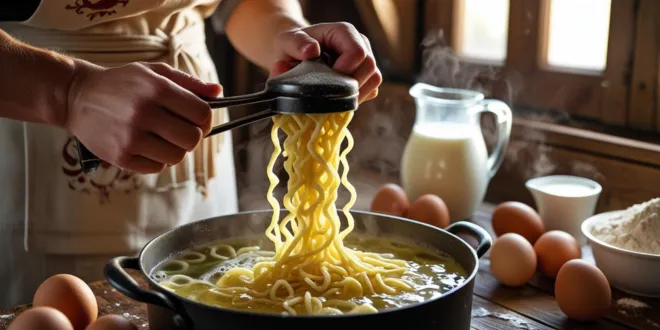Spätzle, often hailed as Germany’s favorite egg noodles, is a beloved staple of Southern German cuisine—especially in the Swabian region. These soft, tender unique noodles are made from a simple batter of eggs, flour, and milk, then gently boiled to perfection.
More than just a side dish, Spätzle plays a central role in traditional meals like Käsespätzle, making it a highlight of vegetarian German food culture. With roots stretching back centuries, the history of Spätzle reflects a legacy of home cooking, resourcefulness, and regional pride.
Often handmade and served warm with butter or paired with rich meat dishes, Spätzle offers a comforting taste of Germany’s culinary heritage. In this article, we’ll explore what makes Spätzle so special and how it continues to win hearts around the world.
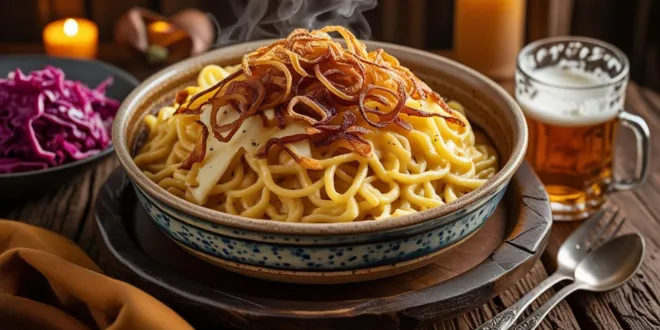
What is Spätzle? A Guide to Germany’s Favorite Egg Noodles
Spätzle is a traditional Southern German dish often celebrated as Germany’s favorite egg noodles. Made from a simple batter of eggs, flour, and salt, these soft, chewy unique noodles are typically hand-scraped into boiling water.
Originating in Swabia, Spätzle has become a symbol of home-cooked comfort. Unlike dried pasta, it’s fresh and tender, often served with butter, cheese, or hearty meat dishes. Its rich texture and versatility make it a beloved staple. Whether enjoyed as Käsespätzle or alongside Sauerbraten, Spätzle offers a delicious introduction to authentic vegetarian German food and regional culinary pride.
The Essence of Southern German Comfort Food
Spätzle captures the heart of Southern German comfort food—simple, satisfying, and deeply traditional. As Germany’s favorite egg noodles, it’s more than a side dish; it’s a cultural icon. Made fresh with basic ingredients, Spätzle delivers a soft, dumpling-like texture that warms the soul. Commonly served with roasted meats or topped with caramelized onions and cheese, it reflects the region’s love for hearty, homemade meals.
Its role in vegetarian German food is especially notable in Käsespätzle, a beloved classic. The history of Spätzle shows how humble kitchen creations can become national treasures. This dish embodies the warmth, flavor, and tradition that define Southern German cuisine.
How Spätzle Differs from Regular Pasta
While both are noodle-based, Spätzle differs significantly from regular pasta. Traditional pasta is made from durum wheat and water, then dried. Spätzle, however, is a fresh batter of eggs, flour, and milk, giving it a softer, more tender texture.
Often classified as a type of unique noodles, it’s closer to a dumpling than Italian spaghetti. It’s not extruded but pressed or scraped into boiling water, resulting in irregular shapes. As Germany’s favorite egg noodles, Spätzle offers a richer flavor and chewier bite. Its versatility shines in both savory and vegetarian German food dishes. Unlike mass-produced pasta, Spätzle celebrates handmade tradition and regional identity.
Why Spätzle Is Called Germany’s Favorite Egg Noodles
Spätzle earns the title of Germany’s favorite egg noodles through its widespread popularity and cultural significance. Found on menus from Bavaria to Baden-Württemberg, it’s a beloved staple in homes and restaurants alike. Made with a high egg content, these unique noodles boast a rich, golden color and delicate flavor.
The history of Spätzle reveals its roots in frugal Swabian kitchens, where every ingredient mattered. Today, it’s cherished as comfort food, especially in vegetarian forms like Käsespätzle. Its handmade nature and versatility make it stand out. Whether served simply with butter or as part of a festive meal, Spätzle remains a true symbol of German culinary heritage.
The Role of Spätzle in Everyday German Meals
In Southern Germany, Spätzle plays a central role in everyday meals. More than just Germany’s favorite egg noodles, it’s a dietary staple. Families often prepare it fresh for Sunday dinners or holiday feasts. Its mild flavor pairs perfectly with rich stews, roasted meats, and gravy. As a key part of vegetarian German food, Spätzle shines in Käsespätzle, a cheesy, comforting dish.
Even in modern kitchens, traditional methods endure. The history of Spätzle shows how this humble food evolved from peasant fare to national favorite. Its presence on the table signals warmth, care, and cultural pride—making Spätzle not just food, but a tradition passed through generations.
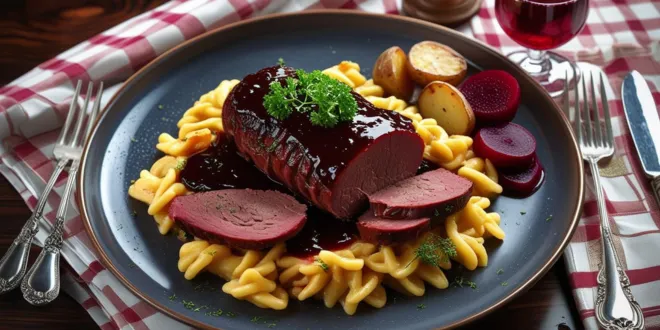
Spätzle Recipe: How to Make Traditional German Egg Noodles at Home
Making traditional Spätzle at home is easier than you think. Start with 3 eggs, 2 cups flour, ½ cup milk, salt, and a pinch of nutmeg. Mix into a sticky batter. Let it rest 15 minutes. Bring salted water to a gentle boil. Using a Spätzle press or perforated spoon, press batter into the pot. Cook for 2–3 minutes until they float. Drain and toss with melted butter.
This recipe yields soft, chewy unique noodles perfect as Germany’s favorite egg noodles. Serve with cheese or meat. For vegetarian German food, add fried onions. With minimal ingredients and maximum flavor, homemade Spätzle connects you to centuries of Swabian tradition.
Is Spätzle the Same as Pasta? Understanding Germany’s Unique Noodles
Spätzle is not the same as pasta—though both are noodle-like, they differ in origin, texture, and preparation. Pasta is typically dried and made from semolina; Spätzle is fresh, soft, and made from an egg-rich batter. These unique noodles are more akin to dumplings than spaghetti. The history of Spätzle traces back to Swabia, where it was handmade from simple pantry staples.
As Germany’s favorite egg noodles, it’s often served with savory sauces or cheese. Unlike Italian pasta, Spätzle is rarely found in dried form. It’s a key part of vegetarian German food and a testament to regional craftsmanship and comfort.
Why Spätzle Stands Out as Unique Noodles
Spätzle stands out as unique noodles due to its handmade nature, irregular shape, and soft, dumpling-like texture. Unlike uniform pasta, no two Spätzle are identical—each batch reflects the cook’s touch. Made from eggs, flour, and milk, they’re richer and more tender. As Germany’s favorite egg noodles, they’re deeply tied to Southern German identity.
Their versatility makes them ideal for both meaty and vegetarian German food dishes. The history of Spätzle shows centuries of tradition, yet it remains fresh and relevant. Whether served plain with butter or baked with cheese, Spätzle offers a taste of heritage, craftsmanship, and comfort in every bite.
Regional Variations Across Southern Germany
Across Southern Germany, Spätzle takes on delightful regional variations. In Swabia, it’s small and irregular, often made with a board (Spätzlebrett). In Bavaria, it’s slightly larger and sometimes mixed with spinach. Some areas add herbs or cheese to the batter. In Austria and Alsace, similar versions appear under different names.
These variations highlight the flexibility of Germany’s favorite egg noodles. As unique noodles, they adapt to local tastes while maintaining tradition. Even in vegetarian German food, regional touches shine—like apple sauce in Franconia. The history of Spätzle isn’t monolithic; it’s a living tradition shaped by family recipes and regional pride.
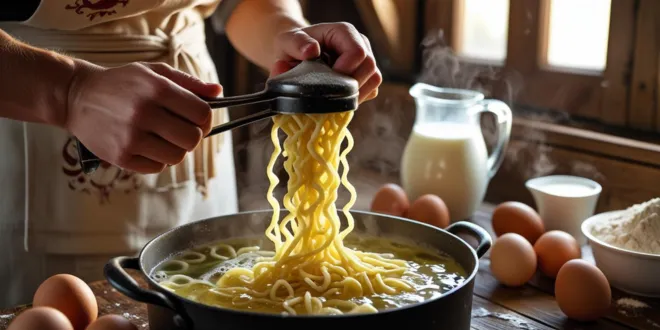
The History of Spätzle: From Swabian Kitchens to Global Tables
The history of Spätzle begins in Swabia, where frugal home cooks created it from basic ingredients. Originally called “Spatzen,” meaning “sparrows,” due to their irregular shape, these unique noodles were a peasant food. Over time, Spätzle became a symbol of regional pride. By the 18th century, it spread across Southern Germany.
Today, it’s celebrated as Germany’s favorite egg noodles, found in homes and restaurants worldwide. Its journey reflects how simple dishes gain cultural importance. As part of vegetarian German food, Käsespätzle gained global fame. Now, Spätzle appears in fusion dishes, proving that tradition can travel far beyond its origins.
What’s in a Name? The Meaning of “Spätzle”
The word “Spätzle” comes from the Swabian dialect, derived from “Spatz,” meaning “sparrow.” Because the irregular shapes of handmade Spätzle resembled little birds, they were nicknamed “little sparrows.” Over time, “Spatz” became “Spätzle” (diminutive form). This playful name reflects the dish’s humble roots
As Germany’s favorite egg noodles, the name now evokes tradition and comfort. The history of Spätzle shows how language and food evolve together. Even today, some regions use “Knöpfle” (little buttons) for smaller versions. Understanding the name adds depth to this beloved dish and its place in vegetarian German food culture.
How Spätzle Spread Across Germany and Beyond
Spätzle began in Swabia but gradually spread across Germany, carried by migration and regional exchange. As railroads and trade grew, so did the popularity of Germany’s favorite egg noodles. By the 20th century, Spätzle was common in Bavaria, Baden, and even Austria. German immigrants introduced it to the U.S., Brazil, and beyond.
Today, restaurants worldwide serve Käsespätzle as a taste of vegetarian German food. The history of Spätzle reflects cultural diffusion—how a local dish becomes national, then global. Modern food trends have embraced it as unique noodles with artisanal appeal. From village kitchens to urban eateries, Spätzle continues to win hearts.
Vegetarian German Food: Spätzle as a Comfort Dish
Spätzle is a star of vegetarian German food, offering warmth and satisfaction without meat. The most famous example is Käsespätzle—layers of buttered Spätzle, melted cheese, and crispy onions. This dish proves German cuisine isn’t all sausage and schnitzel. As Germany’s favorite egg noodles, Spätzle is naturally vegetarian and easily veganized.
Its soft texture and rich flavor make it ideal comfort food. The history of Spätzle shows it was often made when meat was scarce, highlighting its role in plant-based eating. Today, it’s celebrated in vegetarian restaurants and home kitchens alike—proof that tradition and taste can thrive without animal products.
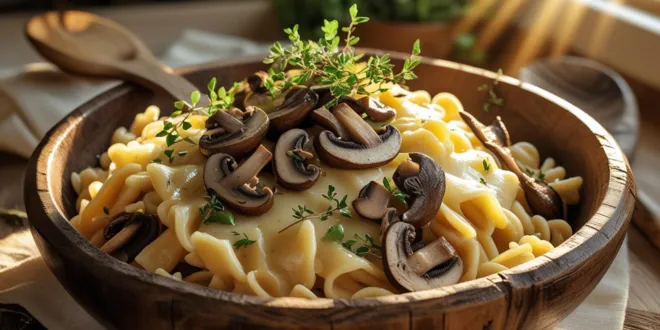
Spätzle with Sauerbraten: A Classic German Meal Combo
Spätzle with Sauerbraten is a classic German combo that balances rich and tangy flavors. Sauerbraten, a marinated pot roast with sweet-sour gravy, pairs perfectly with soft, buttery Spätzle. This dish showcases Germany’s favorite egg noodles as the ideal side—soaking up sauce without overpowering the main.
The unique noodles add heartiness and texture. Though not vegetarian, this meal highlights Spätzle’s versatility. In some regions, a vegetarian version uses mushrooms or seitan. The pairing reflects traditional Southern German dining: generous, flavorful, and deeply satisfying. It’s a must-try for anyone exploring authentic German cuisine beyond sausages and beer.
Step-by-Step Guide to Serving the Ultimate German Plate
To serve the ultimate German plate, start with freshly cooked Spätzle, tossed in browned butter. Prepare Sauerbraten by slow-cooking beef in a marinade of vinegar, water, and spices. Serve the meat with its rich gravy.
Plate the Spätzle beside or under the Sauerbraten to soak up juices. Add a side of red cabbage and potato dumplings for authenticity. Garnish with parsley. For vegetarian German food, use mushroom Sauerbraten. This meal celebrates Germany’s favorite egg noodles and regional flavors. The history of Spätzle meets modern taste in a dish that’s hearty, balanced, and unforgettable. Gemütlichkeit guaranteed!
conclusion
Spätzle is much more than just a noodle—it’s a symbol of Southern German heritage and comfort. Known as Germany’s favorite egg noodles, these unique noodles blend simplicity and flavor in every bite. With a rich history of Spätzle rooted in Swabian kitchens, it has grown into a beloved dish across Germany and beyond.
Whether enjoyed as vegetarian German food like Käsespätzle or paired with Sauerbraten, Spätzle showcases the heart of German home cooking. Its versatility, tradition, and warmth continue to win global admiration, making it a true culinary treasure worth savoring.
1. What exactly is Spätzle?
Spätzle is a traditional German egg noodle made from a simple batter of eggs, flour, and milk. Known as Germany’s favorite egg noodles, they are soft, fresh, and often handmade. These unique noodles are a staple in Southern German cuisine and a comforting base for many dishes.
2. Why is Spätzle called Germany’s favorite egg noodles?
3. Are Spätzle the same as pasta?
No, Spätzle are not the same as pasta. Though both are noodle-like, Spätzle are softer, fresher, and more dumpling-like. As unique noodles made from an eggy batter, they differ in texture and preparation from dried Italian pasta, offering a distinct experience in German cuisine.
4. What makes Spätzle unique noodles?
Spätzle are considered unique noodles due to their handmade irregular shape, soft chewiness, and fresh preparation. Unlike mass-produced pasta, each batch reflects personal touch. Their versatility in both savory and vegetarian German food dishes, like Käsespätzle, sets them apart in global comfort food.
5. What is the history of Spätzle?
6. Is Spätzle considered vegetarian German food?
7. Can you make Spätzle without eggs for a vegan version?
8. What’s the best way to serve Spätzle?
9. How do regional variations affect Spätzle?
10. Can Spätzle be frozen for later use?
Yes, cooked Spätzle can be frozen for up to 3 months. Spread them on a tray to freeze individually, then store in a bag. Reheat in boiling water or a pan. This makes preparing Germany’s favorite egg noodles ahead of time easy and convenient for busy cooks.

